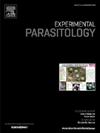热带血吸虫病的分子诊断:巴基斯坦物种特异性qPCR检测的发展和验证
IF 1.6
4区 医学
Q3 PARASITOLOGY
引用次数: 0
摘要
其背景是蜱传血原动物寄生虫,具有重要的经济意义,威胁着牲畜的健康和生产力,特别是在热带和亚热带地区。在这项研究中,我们开发并验证了一种基于qpcr的诊断试剂盒,用于敏感和特异性检测巴基斯坦开伯尔-普赫图赫瓦省(KP)反刍动物的希氏杆菌感染。该小组包括一项广泛的泛蛲虫检测,以及针对环状蛲虫、细小绦虫、lestoquardi绦虫和ovis绦虫的四项物种特异性检测,这些是感染该地区家养反刍动物的主要物种。方法共检测染蜱动物1026只,其中绵羊514只,山羊462只,牛50只。从有症状的动物身上采集了血液,并选择了51份经显微镜检查确认为大肠杆菌阳性的样本进行进一步分析。采用苯酚-氯仿法提取DNA进行临床验证。引物和水解探针针对18S rRNA基因的高可变V4区设计,从而实现高分辨率的物种鉴定。结果合成的gBlock™基因片段具有良好的线性关系(R2 = 0.982 ~ 0.9965), PCR效率高(86.2% ~ 105.2%),每个反应的检出限为10 ~ 100拷贝。变异系数≤5%,证实重复性好。Pan-Theileria试验检测出47例阳性。18S rRNA基因测序证实了上述结果,并鉴定出3例东方弓形虫,其中2例也通过qPCR检测到。其中一份样本检测呈阳性。总体而言,该试验在该验证集中达到了100%的临床敏感性和特异性,尽管需要更大的多地点现场评估来证实这些发现。结论在巴基斯坦建立了首个基于qpcr的同时检测和分种的综合诊断平台。该工具为在流行地区进行大规模监测、及时诊断和改善对热带血吸虫病的控制提供了一种强有力的方法。本文章由计算机程序翻译,如有差异,请以英文原文为准。
Molecular diagnosis of tropical theileriosis: Development and validation of species-specific qPCR assays in Pakistan
Background
Theileria spp. are economically important tick-borne hemoprotozoan parasites that threaten livestock health and productivity, particularly in tropical and subtropical regions. In this study, we developed and validated a qPCR-based diagnostic panel for the sensitive and specific detection of Theileria infections in ruminants from Khyber Pakhtunkhwa (KP), Pakistan. The panel included a broad-range Pan-Theileria assay as well as four species-specific assays for Theileria annulata, T. parva, T. lestoquardi, and T. ovis, the main species infecting domestic ruminants in the region.
Methods
A total of 1026 tick-infested animals were examined, including sheep (n = 514), goats (n = 462), and cattle (n = 50). Blood was collected from symptomatic animals, and 51 microscopically confirmed Theileria-positive samples were selected for further analysis. DNA was extracted using the phenol-chloroform method for clinical validation. Primers and hydrolysis probes were designed to target the hypervariable V4 region of the 18S rRNA gene, allowing high-resolution species identification.
Results
Analytical validation using synthetic gBlock™ gene fragments showed strong assay performance, with excellent linearity (R2 = 0.982–0.9965), high PCR efficiency (86.2 %–105.2 %), and detection limits of 10–100 copies per reaction. Reproducibility was confirmed with coefficients of variation ≤5 %. The Pan-Theileria assay detected 47 positives. Sequencing of the 18S rRNA gene confirmed these results and additionally identified three cases of T. orientalis, two of which were also detected by qPCR. One sample tested positive for T. ovis. Overall, the assay achieved 100 % clinical sensitivity and specificity within this validation set, though larger multi-site field evaluations are needed to confirm these findings.
Conclusion
This is the first comprehensive qPCR-based diagnostic platform for simultaneous detection and speciation of Theileria spp. in Pakistan. The tool provides a powerful approach for large-scale surveillance, timely diagnosis, and improved control of tropical theileriosis in endemic areas.
求助全文
通过发布文献求助,成功后即可免费获取论文全文。
去求助
来源期刊

Experimental parasitology
医学-寄生虫学
CiteScore
3.10
自引率
4.80%
发文量
160
审稿时长
3 months
期刊介绍:
Experimental Parasitology emphasizes modern approaches to parasitology, including molecular biology and immunology. The journal features original research papers on the physiological, metabolic, immunologic, biochemical, nutritional, and chemotherapeutic aspects of parasites and host-parasite relationships.
 求助内容:
求助内容: 应助结果提醒方式:
应助结果提醒方式:


